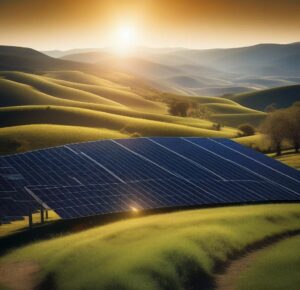 Green energy, also known as renewable energy, is a crucial component of our transition towards a sustainable enery future.
Green energy, also known as renewable energy, is a crucial component of our transition towards a sustainable enery future.
It refers to energy sources that are naturally replenished and have a minimal impact on the environment.
This includes solar power, wind energy, geothermal heat, hydropower, and ocean energy.
By harnessing these resources, we can reduce our reliance on fossil fuels and combat climate change.
Green is not only environmentally friendly but also economically viable, as it offers a long-term solution to our energy needs.
In this article, we will delve into the various types of green energy and explore their significance in creating a greener and more sustainable energy landscape.
Green Energy Key Takeaways
- Green refers to renewable energy sources with minimal environmental impact.
- Solar power, wind power, hydropower, and geothermal energy are examples of green energy.
- Green energy reduces reliance on non-renewable resources and mitigates climate change.
- Green energy provides stable energy prices and job opportunities.
Definition and Importance
The definition of green refers to renewable energy sources that have a minimal impact on the environment and produce little to no greenhouse gas emissions.
Green energy sources such as solar power, wind power, hydropower, and geothermal energy are examples of clean and renewable energy technologies.
These sources offer numerous environmental benefits compared to traditional fossil fuels.
By harnessing green energy sources, we can reduce our reliance on non-renewable resources and mitigate climate change.
Green energy does not contribute to pollution or air pollutants, making it a sustainable and responsible choice for meeting our energy needs.
Green energy sources have the potential to provide stable energy prices, create job opportunities, and pave the way for a more environmentally friendly future.
Types and Examples
Green encompasses various types of renewable energy sources that can be utilized to reduce our reliance on fossil fuels and combat climate change.
These sources include:
Solar power: This involves harnessing the sun’s rays to generate electricity through the use of solar panels.
Solar power is abundant, clean, and can be harnessed on a small or large scale, making it a versatile source of green energy.
Wind power: Wind turbines capture the kinetic energy of the wind and convert it into electricity.
Wind power is a rapidly growing source of renewable energy, with wind farms becoming increasingly prevalent in many countries.
Hydropower: This renewable energy source involves the generation of electricity using flowing water, such as rivers or dams.
Hydropower has been used for centuries and is a reliable and efficient source of green energy.
Geothermal energy: Heat from the Earth’s interior is harnessed to generate electricity or provide heating and cooling.
Geothermal energy is a sustainable and reliable source of green energy, particularly in areas with high geothermal activity.
These examples highlight the diverse range of renewable energy sources available, providing sustainable alternatives to traditional fossil fuels and helping to create a greener future.
Efficiency and Viability
Efficiency and viability of renewable energy sources depend on various factors, including location, conditions, and advancements in technology.
To generate renewable electricity and ensure its successful integration into power generation, it is essential to consider these factors.
Solar energy is most efficient in regions with abundant sunlight, while wind energy thrives in areas with strong, consistent winds. Geothermal energy requires specific geological conditions for optimal power generation.
Advancements in technology, such as improved solar panel efficiency or more efficient wind turbine designs, can significantly enhance the viability of green energy sources.
The economic feasibility of green energy is also influenced by government policies, subsidies, and the overall cost of fossil fuel alternatives.
Environmental Impact
Renewable energy sources have a significantly reduced environmental impact, consistently minimizing pollution and greenhouse gas emissions.
This is a crucial aspect of green energy as it helps combat climate change and promotes a healthier planet.
Here are some key points highlighting the environmental benefits of renewable energy:
- Green energy sources, such as solar and wind power, produce electricity without emitting harmful greenhouse gases, unlike fossil fuels that contribute to global warming.
- By utilizing renewable energy, we can reduce our carbon footprint, which is the total amount of greenhouse gases emitted into the atmosphere as a result of human activities.
- Green energy also helps to reduce air and water pollution, as it does not require the burning of fossil fuels, which releases harmful pollutants into the environment.
- Unlike traditional energy sources that deplete natural resources, renewable energy is sustainable and can be harnessed without causing harm to the environment.
Difference From Renewable and Clean Energy
How does green energy differ from other forms of renewable and clean energy?
While renewable energy refers to energy sources that are naturally replenished, clean energy focuses on reducing greenhouse gas emissions.
Green energy, on the other hand, encompasses both renewable and clean energy sources.
It not only harnesses energy from renewable sources such as solar, wind, geothermal, hydropower, and ocean energy but also ensures minimal environmental impact and low emissions.
Green goes beyond the concept of simply being renewable or clean; it emphasizes sustainability and the protection of our planet.
By prioritizing the use of green energy, we can achieve a more sustainable and environmentally friendly future.
Green Energy Final Thoughts
It is important to note that not all renewable energy sources are considered entirely green, as some may still have associated carbon emissions.
Contact an experienced Realtor!
Bob and Diana
Robert Ratliff RE/MAX Reliance
702-508-8262